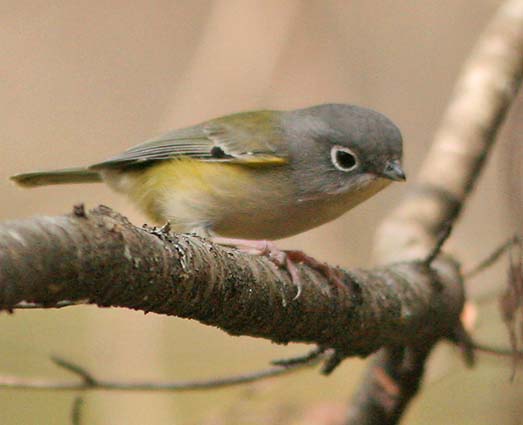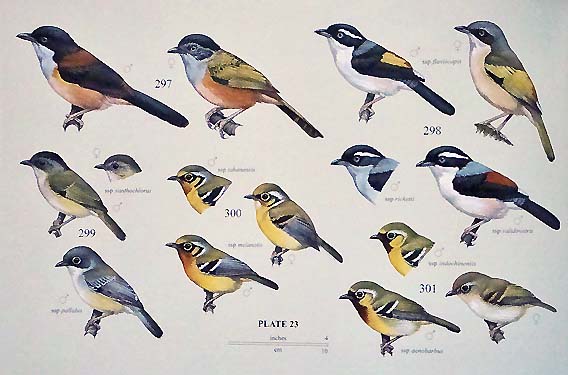
a web page by Don Roberson |
SHRIKE-BABBLERS Pteruthiidae |
|
The old traditional "babbler" family is now split up into five new families [see the new page on the Timaliidae for details], plus offshoot families of birds that have been proven, though biochemical research, to be unrelated to babblers; Alström et al. (2006), Cibois (2003, 2010). Like another "babbler" once known as "White-bellied Yuhina Y. zantholeuca," both proved to be most closely related to New World vireos (Cibois 2003, Alström et al. 2006, Reddy 2008). Truly shocking! Now called Erpornis Erpornis zantholeuca, it and Shrike-babblers are now often placed among the Vireonidae. |
From the standpoint of Family rank, one can view this evidence in three ways: (1) lump all of them (vireos, Erpornis, shrike-babblers) into one family (Vireonidae); (2) lump Erpornis with vireos and split shrike-babblers as a separate family (the Pteruthiidae), or (3) place each of the two Asian groups, both of them early offshoots of the vireonid line, into separate families (Pteruthiidae, Erpornidae) and leave the New World vireos in their own family (Vireonidae). Any of these three approaches is justified by the current evidence. The first approach emphasizes the relationships between these groups. The second approaches emphasizes the long time of divergence of the shrike-babblers. The third approach is a middle ground (chosen here) emphasizing the offshoots that have been separate from vireos for ~24 million years. |
So, for the moment, shrike-babblers are flying at you from your screen as a new family. Yet note the short, rather broad and unusual bill and the large feet. Many vireos have these same characteristics. In central China, we found that Green Shrike-babbler was found in mixed species flocks — which could include babblers, scimitar-babblers, parrotbills, warblers, and woodpeckers — but that Green Shrike-babbler was the "core" species in the flock. It was the "leader" and the rest of the flock coalesced around it. Its vocalizations were a way to follow the flock through thickets and bamboo. There is yet another interesting research study on shrike-babblers. Traditionally, most authorities have listed five species of shrike-babbler. |
Reddy (2008) obtained tissue samples of all five traditional species and most of the 20+ named subspecies, and undertook molecular phylogenetic analyses and a systematic review of their morphology and plumage characters. You can see in the HBW plate that there is much diversity. As just one example, Green Shrike-babbler (#299), as traditionally constituted, there are four named subspecies, two of which lack an eyering [these are Himalayan populations, illustrated by nominate xanthochlorus on the plate] and two of which have an obvious eyering [these are Chinese populations; pallidus is illustrated]. It is also apparent from the painting that some shrike-babblers have strong sexual dimorphism [in contrast, New World vireos lack sexual dimorphism, so shrike-babblers differ in that way]. Reddy's (2008) work was an effort to determine the number of species that such a thorough review might uncover, and she chose to use the Phylogenetic Species Concept (PSC) for her results. In short, she determined that the traditional 5 species should be divided into 19 PSC species. The problem with the PSC is that any single unique trait, even one that lacks any reproductive significance, can be used to "identify" a species. Many evolutionary biologists deplore the PSC concept when applied to definitions of species (see Remsen 2005 for a good overview), and the 'over-splitting' that it engenders can have significant negative impacts on conservation work. Fortunately, as to shrike-babblers, Rheindt & Eaton (2009), undertook a thorough review of Reddy's (2008) work, added vocalizations to the analysis, and reviewed molecular, morphological, and vocal evidence using the Biological Species Concept (BSC), which is by far the primary species concept adopted worldwide. They recommended that the 5 traditional shrike-babblers be expanded to 9 species, and that one other split is likely [i.e., between the eye-ringed and unringed Green Shrike-Babblers] but that evidence from nuclear DNA genetics is needed. I suspect that the 5 traditional shrike-babblers will become 10 shrike-babblers in due course, but that is still just about half of the 19 "species" proposed by Reddy (2008). It is an interesting topic — stay tuned. |
| Photos: The Green Shrike-babbler Pteruthius xanthochlorus was at Foping Nature Reserve, Shaanxi, China, on 12 Nov 2010. All photos © Don Roberson; all rights reserved. |
Bibliographic notes There is no "family book" on the Shrike-babblers (indeed, I am about the only one assigning them Family rank) but the Handbook of the Birds of the World account (Collar & Robson 2007) is excellent, with great photos, although it is not quite up with the most current taxonomic findings, most of which regarding shrike-babblers postdate its publication. Literature cited:
|
 The
Shrike-babblers are a small group of south Asian birds, traditionally
considered to be "Babblers" in the old, traditional family Timaliidae.
One example is Green Shrike-babbler (left).
The
Shrike-babblers are a small group of south Asian birds, traditionally
considered to be "Babblers" in the old, traditional family Timaliidae.
One example is Green Shrike-babbler (left).  The shrike-vireos (genus Pteruthius)
are indeed related to vireos (Reddy & Cracraft 2007, Reddy 2008).
They do have a unique bill (right; Green Shrike-Babbler again; all
photos on this page). Reddy & Cracraft's analysis, using two
species of shrike-vireos, sequenced two nuclear genes. They found that
shrike-vireos were the sister to a clade that included the North
American vireos and Erpornis. Reddy & Cracraft (2007), followed up
by Reddy (2008), calculated the divergence time of the shrike-babblers
from the remaining Vireonidae at 29.5 million years ago (plus or minus
2.5 million years). We can think of it as about 30 million years ago.
They also estimated the divergence of Erpornis from the New World
vireos at 23.8 million years ago (plus or minus 2.8 mya).
The shrike-vireos (genus Pteruthius)
are indeed related to vireos (Reddy & Cracraft 2007, Reddy 2008).
They do have a unique bill (right; Green Shrike-Babbler again; all
photos on this page). Reddy & Cracraft's analysis, using two
species of shrike-vireos, sequenced two nuclear genes. They found that
shrike-vireos were the sister to a clade that included the North
American vireos and Erpornis. Reddy & Cracraft (2007), followed up
by Reddy (2008), calculated the divergence time of the shrike-babblers
from the remaining Vireonidae at 29.5 million years ago (plus or minus
2.5 million years). We can think of it as about 30 million years ago.
They also estimated the divergence of Erpornis from the New World
vireos at 23.8 million years ago (plus or minus 2.8 mya).  For
the moment, I chose the latter approach. It seems to me to be the most
consistent with the current approach to Family level taxa. For example,
Beresford et al. (2005) wrote, in reviewing the evolution of a group of
African warblers, that the "basal divergences among Old World warblers
range from 32.3 mya between the Spenoeacus clade and remaining warblers to 31.3 mya between megalurine and other warblers." The Spenoeacus clade mentioned is now widely considered a separate family, the Macrosphenidae [
For
the moment, I chose the latter approach. It seems to me to be the most
consistent with the current approach to Family level taxa. For example,
Beresford et al. (2005) wrote, in reviewing the evolution of a group of
African warblers, that the "basal divergences among Old World warblers
range from 32.3 mya between the Spenoeacus clade and remaining warblers to 31.3 mya between megalurine and other warblers." The Spenoeacus clade mentioned is now widely considered a separate family, the Macrosphenidae [ These five are shown on Hilary Burn's plate in Vol. 12 of the Handbook of the Birds of the World
(right), where shrike-babblers still appear among the old Timaliidae
(Collar & Robson 2007). These are (keyed to numbers on the plate):
These five are shown on Hilary Burn's plate in Vol. 12 of the Handbook of the Birds of the World
(right), where shrike-babblers still appear among the old Timaliidae
(Collar & Robson 2007). These are (keyed to numbers on the plate):